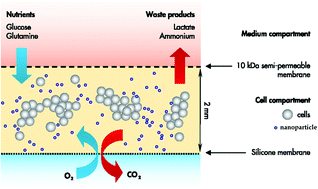Reaction of monocytes to polystyrene and silica nanoparticles in short-term and long-term exposures†
Abstract
Nanoparticles (NPs) are increasingly used in industrial, health and consumer products. In addition to the intended effects, NPs may also cause cell damage. Typical cytotoxicity assays assess short-term effects in adherent cells but do not evaluate longer exposure times and do not focus on cells in suspension. Since NPs are not removed easily from the organism, non-biodegradable NPs may persist in the systemic circulation and affect monocyte function at low concentrations. To mimic this situation, THP-1 monocytes were exposed to low concentrations of plain polystyrene particles (PPP) in different sizes for short (24 h) and prolonged (16 d) time periods. CELLine CL350, a small two-chamber bioreactor, and sub-culturing in flasks were compared regarding prolonged cytotoxicity testing. Uptake rates of the particles, cytotoxicity screening assays, and interleukin secretion were used for the identification of adverse effects. After 24 h, 50 μg ml−1 20 nm PPP did not affect cellular viability and interleukin secretion, while at higher concentrations the cytotoxicity of PPP (20 nm–500 nm) was correlated to surface area. After 16 d of exposure at 50 μg ml−1 20 nm PPP, the decrease in cell number and the increase in interleukins were significant. 200 nm PPP, by contrast, caused only minimal effects. Due to lower reproducibility, CELLine proved to be less suitable for the assessment as compared to sub-culturing in flasks. After prolonged exposure, silica Aerosil OX50 particles also were more cytotoxic towards THP-1 monocytes. The data suggest that prolonged exposure to NPs leads to cytotoxicity at low doses and that induction of cell death may be involved in the observed pro-inflammatory action of NPs.

- This article is part of the themed collection: Nanotoxicology

 Please wait while we load your content...
Please wait while we load your content...